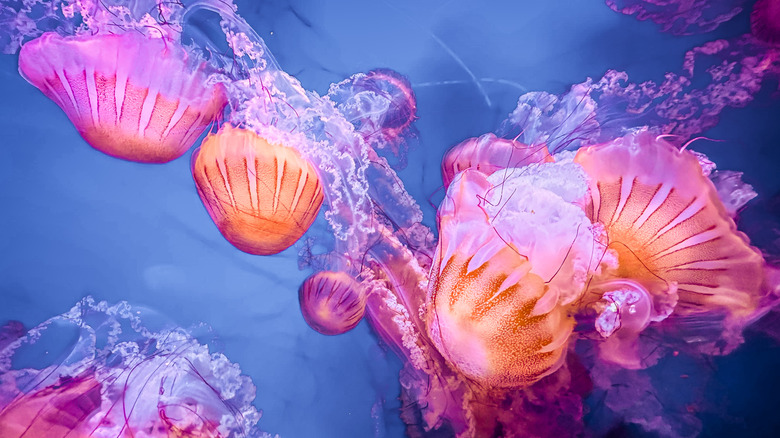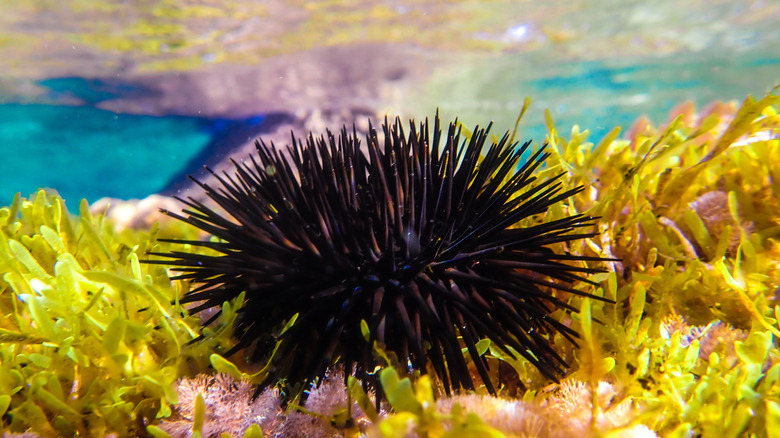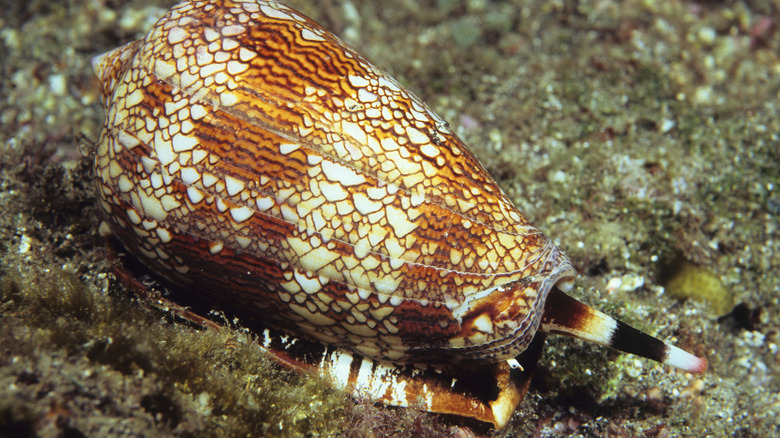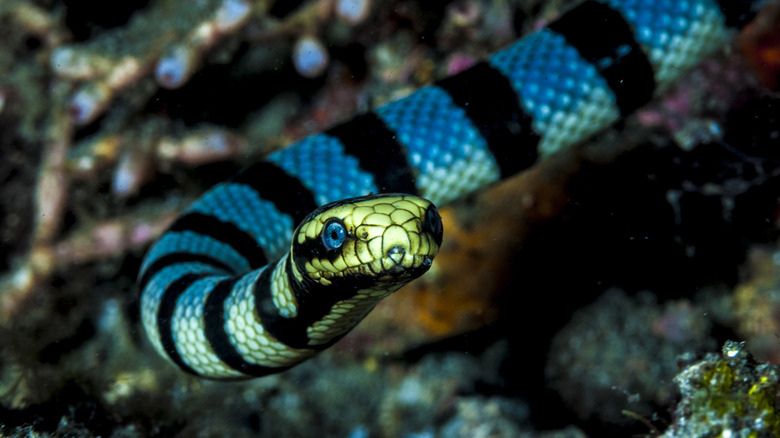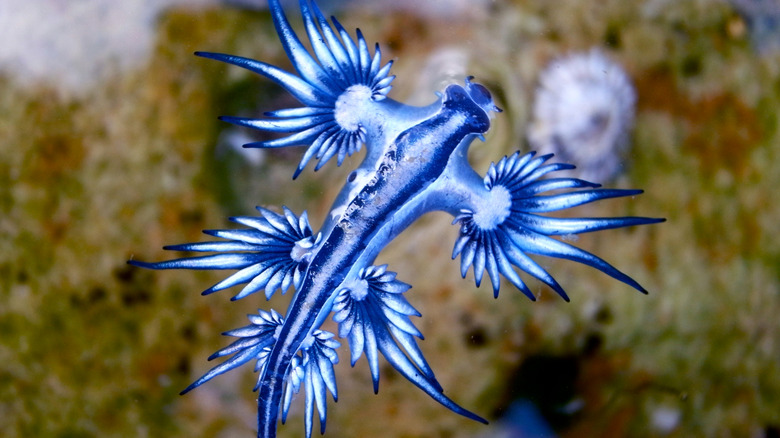5 Dangerous Creatures To Look Out For When Exploring A Shoreline
Many people love to visit the beach. It's a great way to cool down during the summer and offers the chance to soak up the sun, swim in the water, and just run around and play without abandon. However, though it can be fun, there are also some hazards on the shoreline you don't always think about while exploring — like the presence of wild animals. Most regularly stay in the water, but occasionally due to strong waves or bad storms, they get washed ashore.
Generally, when you think of dangerous creatures near the shoreline, sharks come to mind. Some species can wander into the shallows and attack humans, mistaking them for seals. However, you may have to watch what you bump into on the shoreline as well. From creatures made up of sharp needles to ones that can harm you with just a touch, there are dangers on the shore you need to be aware of, so you can avoid grabbing them, or accidentally stepping on them while enjoying your beach trip. After all, nothing puts a damper on a vacation more than a trip to the hospital.
Jellyfish
You can't have a list of dangerous animals to come across on a beach without mentioning jellyfish. There are over 2,000 known species, though it's thought the ocean might hold as many as 300,000. They are a diverse group, all belonging to the phylum Cnidaria. When ranking by the threat they pose to people, there are 11 types of jellyfish that have a high danger level and should be avoided as much as possible, including sea nettles, sea wasps, and box jellyfish.
Humans stumble across these interesting animals all the time when in the ocean. It's estimated that every year, over 150 million people come into contact with these unique sea creatures. A sting from a jellyfish can leave welts, burning, itchiness, swelling, and throbbing. For some individuals (or those who face several stings), heart issues, muscle spasms, headaches, confusion, vomiting, and stomach pain can also occur. Thankfully, though a sting can be painful, the chances of death are fairly minimal. Carry a beach-specific first-aid kit so you can make sure you don't panic and know exactly what you should do if you get stung by a jellyfish.
In the water, it's not always easy to see these animals. However, you can take steps to avoid them floating around you by staying in groups, wearing protective clothing, and avoiding jellyfish season. If you come across one stranded on the beach, you may want to help it, but unless you are taking proper precautions, you are going to hurt yourself and the jellyfish. While the top of the jellyfish doesn't contain stingers, the tentacles may be hidden, or some of the cells may have broken off and gotten stuck on the top, which means there's always a chance of getting stung.
Sea urchins
Sea urchins, family Echinoidea, are distantly related to sea stars, sand dollars, and sea cucumbers, alongside other ocean creatures. Most of the time, sea urchins live in crevices and holes. However, when the sea is rough, they sometimes get swept up and end up on shores or in shallow water. This is when they can be quite dangerous for the unsuspecting beachgoer. Sea urchins are covered in little spines, somewhat reminiscent of a hedgehog.
Not only do they hurt to stand on, but most species have spines tipped with small pincers made to keep them in your skin even after they break off from the urchin itself. If that wasn't bad enough, some species have toxins. While they aren't generally deadly if you step on them, it can be pretty painful, leading to infections, muscle aches, and swelling. Getting several stings in a row can cause more severe symptoms, like weakness, shock, and difficulty breathing. Additionally, not taking out the spines that break off in your skin can lead to infections and muscle pain. They are found in the United States, among other countries, and are one of the creatures you need to beware of when swimming at Florida's gorgeous beaches.
Thankfully, as long as you pay attention to where you are walking and step carefully, you can avoid injuries. Since sea urchins only release their toxin with pressure and the breaking of their spines, you can move them as long as you are gentle, to keep them out of harm's way. You can also wear water shoes, like the Maxome Quick Dry Water Shoes, if you are walking along the shallows, as their spines are often too fragile to break through thick and solid soles.
Cone snails
Cone snails — part of the Conidae family — are quite beautiful marine animals, with colorful shells full of geometric patterns. However, don't let their decorations fool you — these are quite dangerous animals, and are considered to be some of the most venomous creatures in the entire world. Every cone snail species has a slightly unique blend of toxins that work in different ways, including affecting how long they last and how quickly they take to set in once their prey is stung.
In fact, their venom is so good at blocking the nerves that it's found some useful applications in the health field, specifically as pain blockers. Stumbling across one in the wild though can lead to pretty nasty symptoms, including numbness, tingling, pain, and even paralysis in some severe cases. Thankfully, they rarely get a chance to do so, as the only times they sting people are when they are stepped on, or someone picks them up on the beach. So as long as you pay attention to where you are walking, and don't go picking up any strange shells, you shouldn't have to worry about these little creatures.
Cone snails are found all over the world. Anywhere the water is tropical and temperate, you may come across a cone snail in the shallows. Hawaii is included, and this species is one of several creatures you want to beware of when swimming in Hawaiian waters.
Sea snakes
There are several species of sea snakes divided into two subfamilies — Hydrophiinae and Laticaudinae — and all of them are fairly dangerous. Some produce venom that is up to 10 times more deadly than a cobra. The leading theory as to why these animals are so dangerous is that sea snakes must immobilize their prey quickly so they are unable to swim away, as they don't have the luxury of waiting for their catch to die like their terrestrial cousins. Thankfully, many of them are rather calm species and avoid humans as much as possible. Sea snakes also have a habit of delivering dry bites, where they don't release venom when they attack people.
Sea snakes are often found in warmer locations, such as parts of the Indian Ocean, or near Southeast Asia and Australia. Usually, they are found in the open water. However, they do on occasion end up near or on shore. This is when sea snakes are at their most aggressive, as they do not have the capability to move across the sand like normal snakes, and end up trapped in place. People who pass by too close, whether by accident or to help, may end up being bitten by a stuck snake that is unable to run away.
Blue sea dragon
Glaucus atlanticus — also known as the blue sea dragon, blue angel, or sea swallow — is a type of mollusk. It's a kind of sea slug, and rarely gets above 3 centimeters long. They're most often found along the Atlantic, Pacific, and Indian Oceans. Parts of the latter are already considered some of the most dangerous spots to surf in the whole world, but this tiny creature may make it feel even more deadly.
Like poison dart frogs, these little creatures aren't inherently dangerous. Instead, they become venomous thanks to what they eat. Despite their small size, they feed on prey like the Portuguese man-o'-war. As they eat, the venom from their food toxifies the slug and makes them dangerous to the touch. In fact, the poison builds up, which leads to them being even more deadly with every meal.
Usually, the blue sea slug floats along in the open ocean, and you aren't likely to come across one. They create small air bubbles that keep them on the surface of the water and allow them to float along with the waves. However, in certain weather conditions they may wash up on shore. These little creatures may be adorable, but even a gentle touch from this animal can lead to a painful reaction, and you should keep far, far away from them if they end up on the shoreline. Similar to jellyfish, these little creatures are dangerous even if they are already dead, so never try and touch one with your bare hands.

